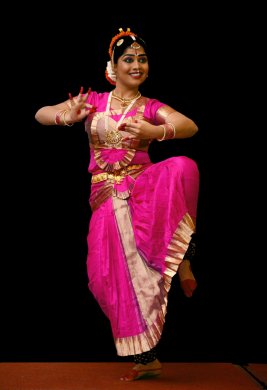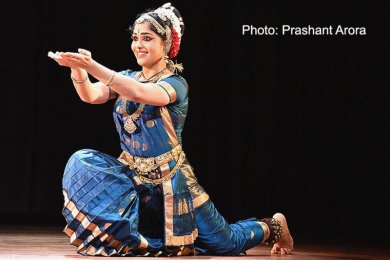 |  Follow us    
  |
 |  Follow us    
  |
 Kuchipudi recital Nisanta by Sarvani Yadavalli Kuchipudi recital Nisanta by Sarvani Yadavalli- Nita Vidyarthi e-mail: nitavidyarthi@gmail.com September 29, 2017 A young chemical engineer Sarvani Yadavalli from Chennai presented a scintillating Kuchipudi recital 'Nisanta' under the Horizon series of ICCR at the Satyajit Ray auditorium, Rabindranath Tagore Centre, Kolkata. She has learnt the art form from Dr. Sobha Naidu, Seetha Nagajothy, Vedantam Radheyshyam and Rajaram from a very young age and has emerged as a sophisticated dancer. She proposes to address social issues and attempt to bring peace and harmony. She has started Sahasra Fine Arts in order to train others in this beautiful art form. Sarvani was compelling in her one hour recital presented in three segments. She began with the anecdote of how Mahakavi Kalidas become a scholar and the sloka from Kalidas's work Shyamala Dandakam. This was followed by "Mamavatu Sri Saraswati", a composition of Mysore Vasudevachar (Hindolam, adi) in praise of Goddess Saraswati. Her beginning was proof enough of her technical ability and spontaneity which comes from years of training. After a brief introduction with graceful hand gestures of the Pravesa Daruvu tradition in Kuchipudi, she rendered an aesthetically sensitive "Vachenu Alamelumanga," the Annamacharya keertana which was choreographed in the traditional Kuchipudi dramatic style by drawing from the Pravesa Daruvu, describing the beautiful qualities and characteristics of Alamelumanga, the consort of Lord Venkateswara. Alamelumanga arrived gracefully with her shining emerald anklets, while Rambha and other celestial damsels worshipped with their graceful movements and showcased their talents in dancing by expressing the navarasas. Sarvani's dignified entry and walk as Alamelumanga with her jingling bells, displayed adequate maturity in abhinaya and skill in the nritta required for a highly confident dancer. There was a certain amount of elegance in her hastas and upper torso even while she was simultaneously executing her lower torso or foot strongly. The repetition of the line "Gambhira gatalanu meera" and its execution with the nritta passages interspersed was delightful as was the soul-stirring singing. Unfortunately the singer could not be known. Another phrase "Smitalalitha kapuram snighdha sangeetalolam" appealed. The episodes showing the navarasas were taken from Bhagavatam. The love between Krishna and Radha was portrayed through sringara rasa, the mischievous acts of baby Krishna in hasya rasa, the Kubja episode displayed karuna, Krishna in Geetopadesham displayed roudra, the defeat of Chanura as veera rasa, Kamsa's fear to die in the hands of Krishna as bhayanaka rasa, the disgust experienced by Krishna after seeing the downfall of Yadavas as bheebatsa rasa, and the Kalinga Nartanam by Krishna as adbhuta rasa. The outstanding episodes were the veera rasa and Kalinga Nartanam. Kubja was ordinary as was the sringara rasa with predictable expressions and movements. The piece was set to ragamalika and adi tala.  The concluding presentation was the tarangam "Nanda Nandana Gopala"
(Ragamalika, adi) written by Saint Narayana Teertha. The episode of
Krishna lifting the Govardhana Mountain to protect his cattle and the
people of Brindavan from Indra's wrath (also plan) was performed with
confidence and ease. Her abhinaya as well as her nritta using the
appropriate jathis full of intricate beats and rhythm and the final
execution on the brass plate with the repetitions of "Gopimanmatha
Goparipalaka Govardhanadhara Gopala" and "Rasamandala nata Rasajanardana
Gopala" brought alive the entire episode wonderfully. Sarvani feels
just like the dancer needs to have more control over body and mind in
order to dance on the brass plate, likewise, every one of us need to
leave the earthly relationships and should have more control on body and
mind in order to reach the Supreme Lord. The concluding presentation was the tarangam "Nanda Nandana Gopala"
(Ragamalika, adi) written by Saint Narayana Teertha. The episode of
Krishna lifting the Govardhana Mountain to protect his cattle and the
people of Brindavan from Indra's wrath (also plan) was performed with
confidence and ease. Her abhinaya as well as her nritta using the
appropriate jathis full of intricate beats and rhythm and the final
execution on the brass plate with the repetitions of "Gopimanmatha
Goparipalaka Govardhanadhara Gopala" and "Rasamandala nata Rasajanardana
Gopala" brought alive the entire episode wonderfully. Sarvani feels
just like the dancer needs to have more control over body and mind in
order to dance on the brass plate, likewise, every one of us need to
leave the earthly relationships and should have more control on body and
mind in order to reach the Supreme Lord. The choreography of all the pieces presented is by Dr. Sobha Naidu and the dancer has correlated each item to the present day scenario and explained how the epics conveyed messages for the entire mankind to follow to have a peaceful life. The dancer herself explained the items and took the audience through a beautiful journey of Nisanta in her spellbinding recital. During a conversation, Sarvani answered a few questions. How did you balance your dancing with your professional training? I believe both education and dance complement each other. Luckily, my dance training started when I was young (five) and it continued without any break for ten years. In these ten years I got vigorous training from my gurus in a very traditional guru shishya parampara style. Solid foundation was laid and I started touring along with my guru portraying different characters in dance dramas which not only taught me dance but also made me quite independent looking at life through a different lens. After graduating as the best outgoing student in chemical engineering from BITS, Pilani, I started my job and dancing career simultaneously. I wanted to devote full time to dancing at one point of time and I quit my job. So at every point in my life, I didn't want either my studies/career or dance to suffer. I prioritize and make sure whatever I am doing is done to the fullest. Dance teaches a lot of focus and concentration, it teaches life skills and putting up a show is a big project. It teaches lot of business development, cross cultural management, negotiation, managerial skills which are quite helpful in my job as well. Did you have to take short cuts? No. Because I work as an engineer, no way I choose less elaborate curriculum in dance. I feel both dancing career and my engineering career are two complete ones wherein no shortcuts can be taken. I prefer taking less number of shows but never compromise on the ones I am presenting. When I was working as a dancer full time, I used to perform extensively and travel a lot. Now that I am balancing lot of things, I am very selective when choosing my performances and make sure that I get enough time to think and curate everything that is needed for a performance. So now, I perform less but try my best to do full justice to my performances. All the shows I have done this year are full length shows spanning more than an hour and I have presented different themes in each of my performances. It is not very easy to balance both engineering career and dance career. Dance needs lot of resources and is a full time profession. Handling two full time professions definitely is not easy but not impossible as well. What makes my life very challenging I feel is to manage a toddler. Do you think an hour's recital is enough to showcase your art? I cannot say one hour is not sufficient to showcase my art. In today's fast paced generation, performing for one hour is considered to be a good show. One hour is a good time to show the art form but not the complete repertoire. The popularity of Kuchipudi is suffering. What are your views? Kuchipudi as a dance form has undergone lot of transition. I feel more awareness needs to be created in the audience on the beauty of the art form as even today most of the people don't know the difference between Bharatanatyam and Kuchipudi. There are wonderful dancers in this field and I feel these dancers should perform more often and spread the beauty. The institutions, gurus as well as the students should make sure that they spend enough time to absorb the art form and know it thoroughly before presenting it to the world. This will avoid the misinterpretations of the public on the art form. Serious training from gurus and dedication from the students is required to present the art in its true form and only then can the audience enjoy the beauty of Kuchipudi. Dr. Nita Vidyarthi is a veteran critic of performing arts and writes on dance, music and theatre in leading publications. |